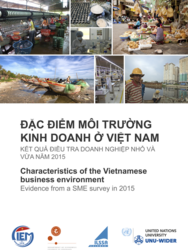Report
Characteristics of the Vietnamese business environment
Evidence from a SME survey in 2015
This is the sixth time that the collaborative small and medium enterprise (SME) panel survey has been conducted among formal and informal manufacturing firms in Viet Nam. The results of previous survey rounds, those of 2005, 2007, 2009, 2011, and 2013 were a motive for UNU-WIDER to approve and take the lead in collaboration with the Institute of Labour Science and Social Affairs (ILSSA) of the Ministry of Labour, Invalids and Social Affairs (MOLISA), the Department of Economics (DoE) of the University of Copenhagen, and the Central Institute of Economic Management (CIEM), to implement another survey in 2015.
The 2015 fieldwork behind this report consisted of face-to-face interviews that were implemented in June, July, and August. Just over 2,600 small and medium-sized non-state enterprises operating in the manufacturing sector were interviewed in ten provinces, namely the cities of Ha Noi, Hai Phong and Ho Chi Minh City (HCMC), and Ha Tay, Phu Tho, Nghe An, Quang Nam, Khanh Hoa, Lam Dong and Long An provinces. The present report is based on the information about enterprises that were interviewed since 2005 and new enterprises that were added as a replacement for those that exited the survey.
The SME biannual surveys referred to above are a result of collaborative research efforts on collecting and analysing data representative of the private sector in Viet Nam. This means that not only large or formally registered enterprises are included in the survey. As such, the SME survey builds on the existing databases created through other initiatives in Viet Nam, aiming to collect data and gain an understanding of the SME dynamics in Viet Nam.
The present report aims to provide researchers and policy makers with an overview of key facts from the 2015 survey round, comparing as appropriate with data from 2013 and earlier years. The report does not contain a complete description of the full range of information available in the dataset. We encourage readers to explore the questionnaires that were used in the collection of data (available online) to see all the issues addressed. Several in-depth studies of selected issues on the Vietnamese private sector economy, exploiting the database, are underway. Subsequent studies will make use of the fact that a sample of approximately 2,600 SMEs is available, including a representative panel dating back to 2005.
 Join the network
Join the network